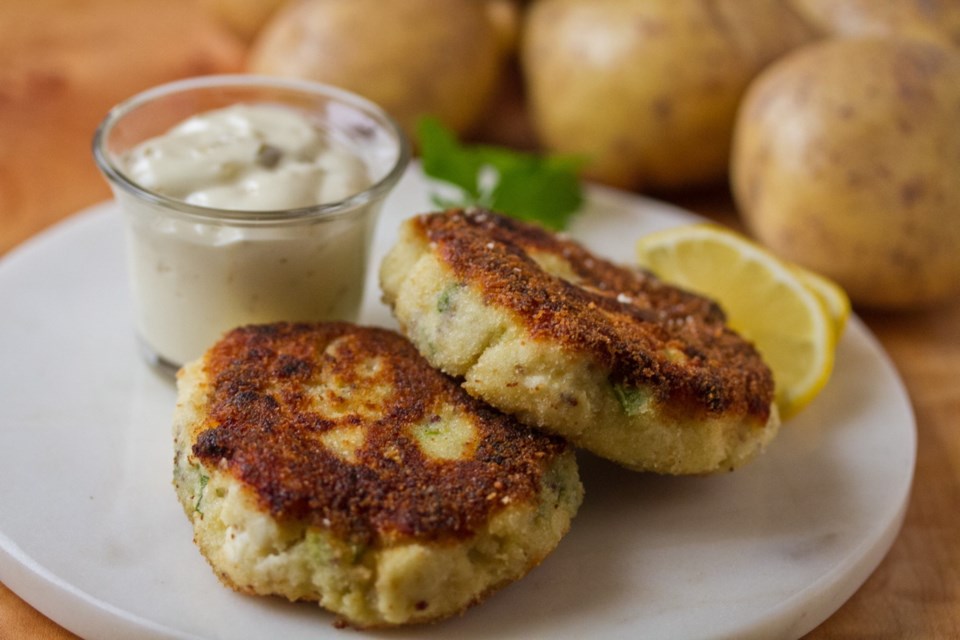Dear Eric: Could you tell me about Yukon Gold potatoes? In stores, are they and ones simply labelled yellow-fleshed the same thing?
George T.
Dear George: The place to start answering your query is to tell you a little about the interesting history of the Yukon Gold potato. Despite its name, the development of this hybrid didn’t occur in the Far North, it happened in southern Ontario.
In the early 1900s, many Dutch and Belgians immigrated to Canada, with some settling and farming in the Lake Erie area, around towns such as Simcoe, Leamington and Harrow. Many of them grew vegetables, such as potatoes.
In an article written on the University of Guelph website, uoguelph.ca, potato-breeder extraordinaire Gary Johnston writes that in 1953 he took over potato research work at an agriculture station in Harrow. Not long after, local growers began petitioning for the breeding and licensing of a yellow-fleshed potato variety similar to what they had grown in Europe.
Johnston and his research team at the University of Guelph potato-breeding program took up the task. After much contemplation, Johnston decided they should try to create a potato variety with shallow eyes, globular shape and yellow flesh.
After years of experimenting, they finally found their nugget by crossbreeding an early-maturing, North Dakotan white potato variety called Norgleam, with a wild South American yellow-fleshed variety.
Johnston suggested they call the potato Yukon, for the Yukon River and gold-rush country.
His colleague, Charlie Bishop, suggested they add the word “gold” to reflect the colour and appearance of the potato.
The Yukon Gold potato was licensed in 1980 and became the first Canadian-bred potato to be marketed and promoted by name. To succeed as a new variety, Johnston believed the potato would require good publicity, and he got it by doing radio, television and print media interviews.
Getting his potato rolling was Harrowsmith magazine, which published an article called There’s Gold in These Hills.
The potato became and still is popular in Canada and the U.S. It is now grown in several locations in North America, including B.C.
The B.C. fresh vegetable growers website, bcfreshvegetables.com, says Yukon Gold potatoes were first grown in Delta in 1987. Because of their colour and texture, they were marketed as “the potato with the butter already in it.”
That website says the Yukon Gold variety is what’s primarily grown in B.C., but there are other quality yellow-fleshed potato varieties grown in this province and elsewhere.
However, you might not know that by the way they are labelled in supermarkets, particularly when sold in bulk, where, no matter what the yellow-fleshed variety, they are simply labelled yellow-fleshed potatoes.
If you’re looking for a specific type of yellow-fleshed potato, such as Yukon Gold, your best bet is to check the bagged-potato section of the supermarket, where I noticed some of the yellow-fleshed potato varieties were identified with their name on the bag.
Yukon Gold and other yellow-fleshed varieties are excellent for such things as roasting, baking, frying and mashing. I did the latter in the recipe below, and then incorporated the mashed potatoes into flavourful fish cakes you could serve as a main dish for lunch or dinner.
Halibut, Yellow-Fleshed Potato and Green Onion Cakes
Moist and inviting, savoury cakes you could serve with a side salad for lunch or dinner.
Preparation time: 30 minutes
Cooking time: About 25 minutes
Makes: 4 servings (2 cakes each)
1 1/4 lb. yellow-fleshed potatoes, such as Yukon Gold, peeled and quartered
1/2 lb. (250 grams) halibut fillet, skin removed
3 green onions, thinly sliced
1 large egg, beaten
1 Tbsp whole grain Dijon mustard
• a few pinches dried tarragon or dill
2 Tbsp all-purpose flour
• salt and white pepper to taste
1/2 cup dried breadcrumbs
3 Tbsp vegetable oil
8 half lemon slices
• homemade or store-bought tartar sauce, to taste
Set the potatoes in a pot and cover with generous amount of cold water. Simmer potatoes until very tender. Drain potatoes well. Set the potatoes back on the heat a minute or so to evaporate any water in the bottom of the pot. Remove from the heat, and then thoroughly mash the potatoes. Spoon potatoes into a bowl and cool to room temperature.
Pat the halibut dry with paper towel. Cut the fish into thin, lengthwise strips. Now cut each strip into small, 1/4- to 1/2-inch cubes. Set the raw, cubed fish in the bowl with the potatoes. Add the green onion, egg, mustard, tarragon or dill, flour, salt and pepper and mix well to combine.
Spread the breadcrumbs on a wide plate. Dampen your hands slightly with cold water. Divide and shape the fish mixture into eight evenly sized balls. Shape each ball into 3-inch wide cake. Coat a fish cake in breadcrumbs, gently pressing the breadcrumbs on to help them adhere. Set coated fish cake on a baking sheet. Repeat with remaining fish cakes.
Place the oil in a large skillet set over medium to medium-high heat. When hot, fry the fish cakes until golden brown and the fish is cooked through, about four minutes per side.
Set two fish cakes on each of four plates. Garnish each plate with two half lemon slices and serve fish cakes with tartar sauce.
Eric Akis is the author of the just-published, hardcover book Everyone Can Cook Everything. His columns appear in the Life section Wednesday and Sunday.
